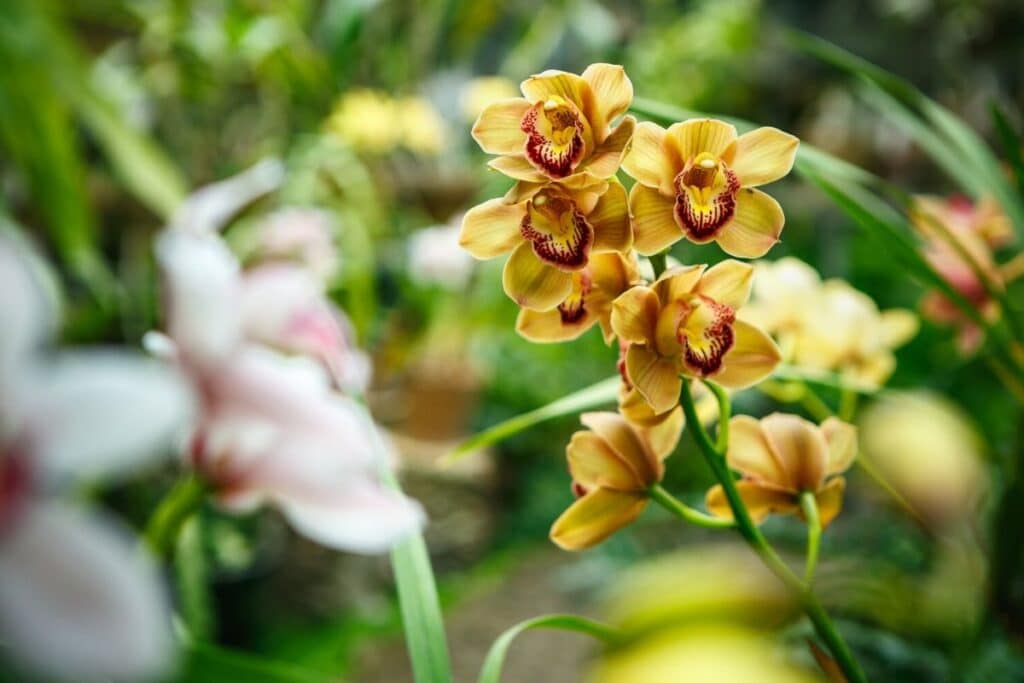Are you fascinated with orchids? If yes, then you’re probably aware of cymbidium orchids, commonly called boat orchids.
Boat orchids are one of the most beautiful types of exotic flowers frequently used in flower arrangements and corsages.
Although they are more demanding than the other types of orchids grown as houseplants, their attractive, long-lasting, and large flower spikes won’t make you think twice about including them in your house plant collection.
Here are some useful facts about cymbidium and a guide on how to grow these orchid flowers.
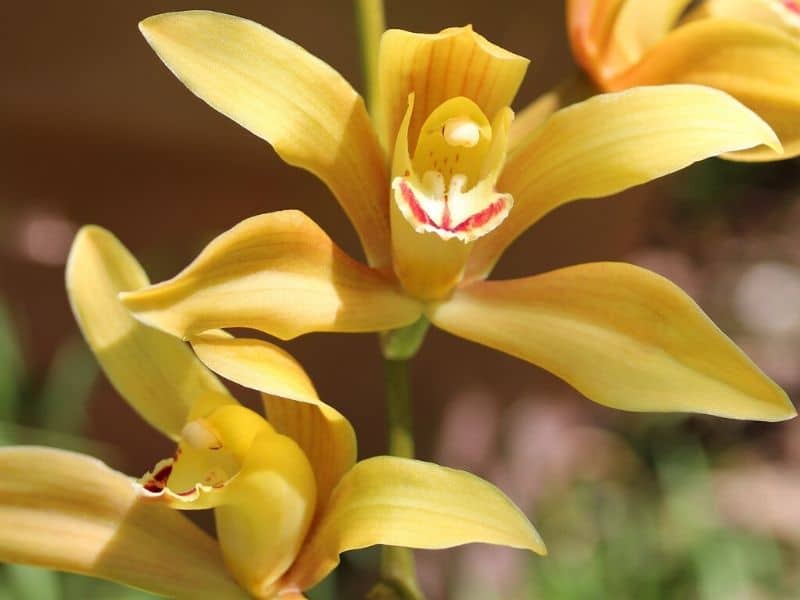
Facts About Cymbidium Orchids
Cymbidium orchids are evergreen plants from tropical and subtropical Asia: Southeast Asia, Australia, and China (1). They are mainly cultivated as potted plants and cut flowers for commercial uses.
The Cymbidium genus is part of the Orchidaceae botanical family. It has hundreds of cultivars available in a wide range of colors, including white, green, yellow, pink, red, and many others, both in miniature and standard sizes (1).
Plant Description
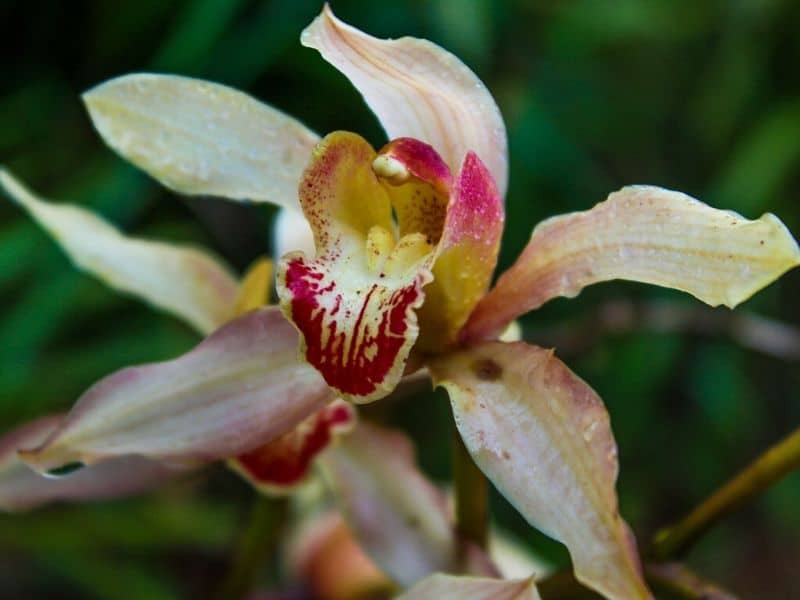
Cymbidium orchids are mostly terrestrial, but some species are epiphytic. There are two general types of this plant: standard cymbidiums, which are large plants with strap-like leaves, and miniature cymbidiums, which are hybrids and smaller in size than the standard type.
The flowers of cymbidiums are large, usually measuring up to 10 cm, with five segments of waxy petals and sepals that are more often not brightly-colored. The common name boat orchid refers to the flower’s unusual, boat-like lip or labellum, which features a hollow portion. The genus name originated from the Greek word kymbe that means boat.
The flowers are showy, grow in clusters on long flower stalks, and last up to 10 weeks. The leaves of boat orchids are green and measure up to at least 35 cm in length (1). They are linear and strap-like, which make them distinct from other types of orchids. They also have large, rounded pseudobulbs, and thick, fleshy roots.
Popular Cymbidium Orchids Species
Noble Orchid (Cymbidium goeringii)
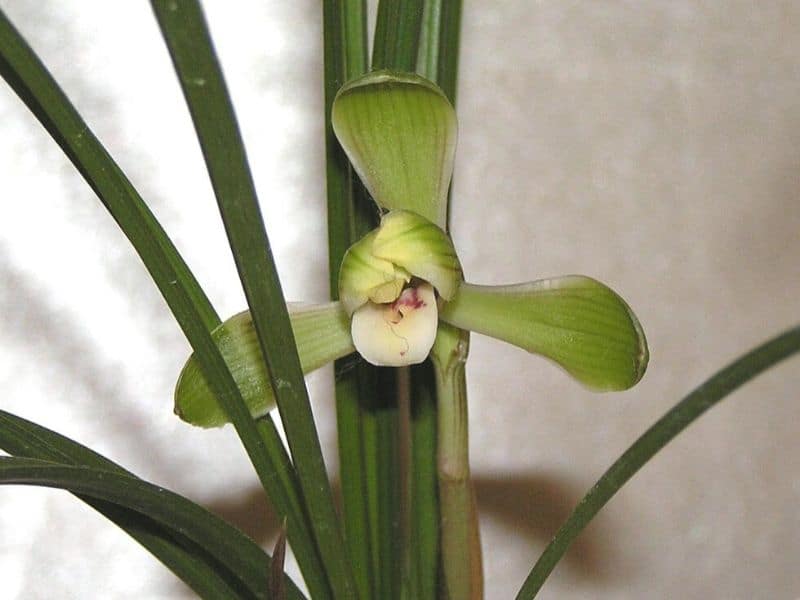
Common names: Noble Orchid, Goering’s Cymbidium, Leek Orchid, Riverstream Orchid, Korean Spring Orchid
Noble Orchids are evergreen small species of cymbidium native to East Asia, including Japan, Korea, India, Bhutan, and China. They are widely cultivated for their beautiful flowers that are not only long-lasting but also fragrant (2). Because of their strong musk fragrance, the flowers have become popularly used as tea flavorings in Japan.
Among the noteworthy features of Cymbidium goeringii are long and grass-like leaves with serrated edges, underground flattened pseudobulbs, and fleshy, thick roots. The solitary to few (up to three) flowers bloom during the winter and spring on a short inflorescence.
This type of cymbidium orchid is cold-tolerant, which makes them popular in China and Japan since the 14th century. Its extract is used in herbal medicine.
Here are some of the most recognized varieties of noble cymbidiums:
- Cymbidium goeringii var. longibracteatum
- Cymbidium goeringii var. goeringii
- Cymbidium goeringii var. tortisepalum
- Cymbidium goeringii var. gracillimum
Four-Season Orchid (Cymbidium ensifolium)

Common names: Four-Season Orchids, Sword-Leaf Orchids, Rock Orchids, Burned-Apex Orchids, Spring Orchids, Day’s Cymbidium
C. ensifolium, or more popularly known as four-season orchid, is another oriental orchid recognized for its fragrant and elegant flowers. It is widely cultivated worldwide, including the Philippines, New Guinea, Borneo, Japan, and China. It showcases beautiful blooms multiple times a year (3).
Four-season orchids are part of the miniature cymbidiums group, growing up to 12” in height. They are also known as the cymbidium with sword-shaped leaves, primarily because of the appearance of the foliage which is straw-yellow to green and grass-like. In fact, the species name ensifolium comes from the Latin words ensis and folium, meaning sword and leaf, respectively.
C. ensifolium ‘Iron Bone’, C. ensifolium ‘Jin He’, and C. ensifolium ‘Su Sin Lan’ are some of the most recognized varieties of this cymbidium orchid.
Chinese Cymbidium (Cymbidium sinense)
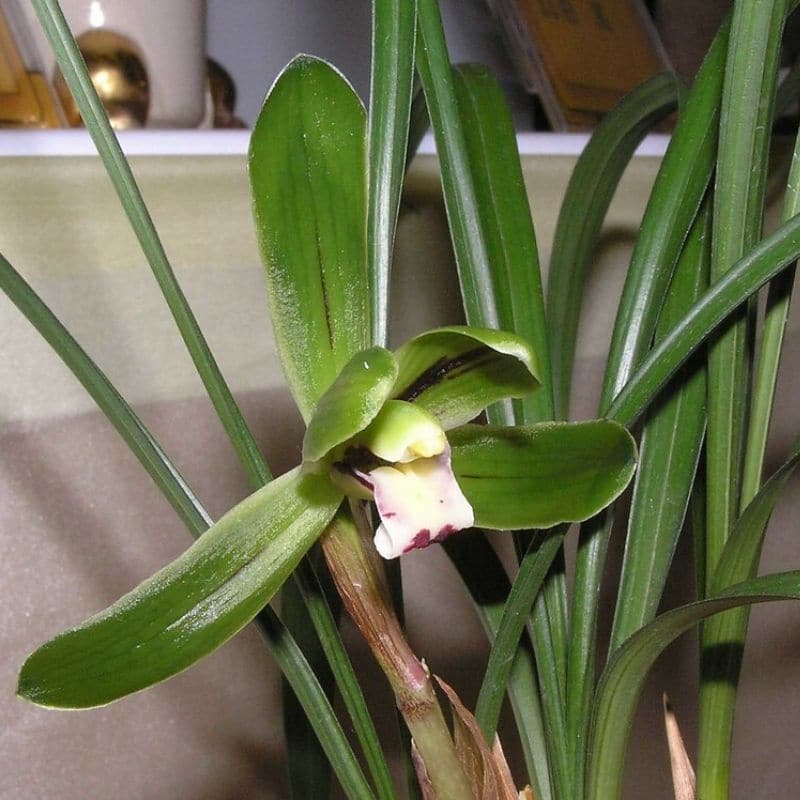
Common name: The Chinese Cymbidium
Chinese cymbidium orchids (C. sinense) are terrestrial orchids endemic to Northern Vietnam and Southern China. Lovely clusters of more or less 20 flowers per inflorescence show an exquisite display during fall to spring. Each flower grows up to 5 cm in width and oozes with fragrance.
This perennial orchid typically grows up to 12 to 18 inches in height with yellow, green, or burgundy flowers and green, strap-like leaves. The leaves emerge from a pseudobulb.
Cymbidium sinense ‘Chin Hua Shan’ is one of the many cultivars of this species. While this compact cultivar produces fewer flowers compared to other popular cultivars of Chinese cymbidiums, the sweet fragrance and overall quality of its flowers outweigh this. Also, the leaves of this cultivar feature variegated edges that make it unique.
Cold Growing Cymbidium (Cymbidium kanran)

Common names: The Cold-Growing Cymbidium, Winter Orchid
C. kanran, also known as the cold-growing orchid, thrives well under cold conditions and a native from China, Japan, and Taiwan. This species of cymbidium orchids is a medium- to a large-sized type that grows from long, large, and cylindrical roots and narrowly ovoid pseudobulbs. It is highly valued as an ornamental primarily because of its delicate scent and attractive flower buds.
The leaves of this species are linear-elliptic, dark green, and often feature serrulate edges towards the tip of the leaf blade. Also, these plants have narrow leaves and petals compared to Chinese cymbidiums, and their flower bracts are longer.
Finlayson’s Cymbidium (Cymbidium finlaysonianum)
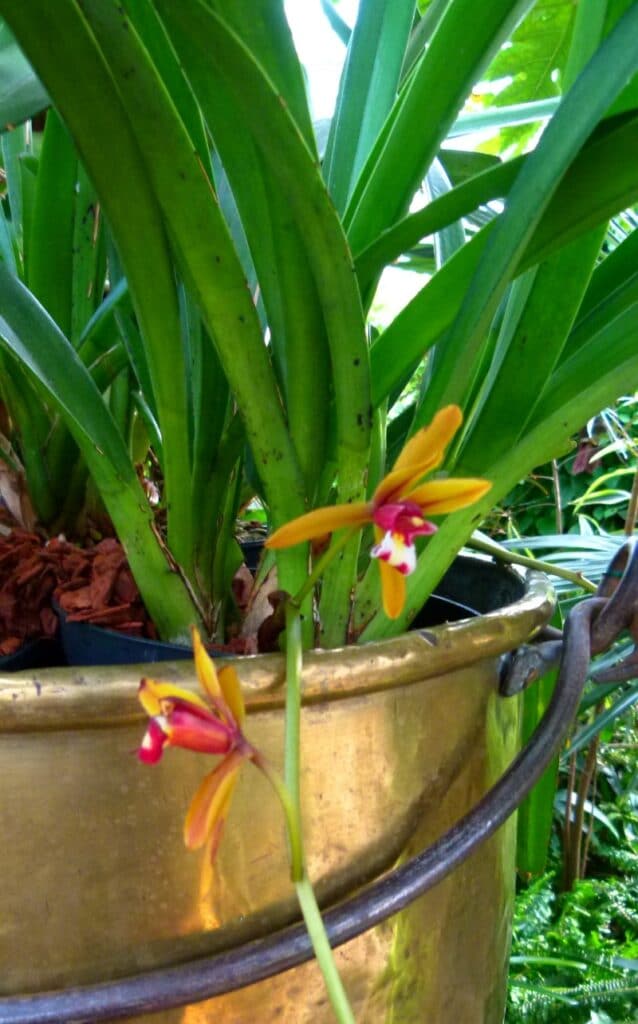
Common name: Finlayson’s Cymbidium
Finlayson’s Cymbidium is a sympodial epiphytic or terrestrial herbaceous orchid that can be found throughout Asia, particularly in the Philippines, Singapore, Malaysia, Thailand, Cambodia, and Vietnam (4).
A renowned ornamental plant, this type of cymbidium orchids features leathery, strap-like leaves that grow up to 80 cm in length and 4 cm in width. Its yellow green flowers can grow up to 5 cm in diameter with a three-lobed lip and curved column (4). The flowers of this orchid range in color from red to white and yellow.
Growing Cymbidium Orchids

Because of their appealing flowers with unique shape and irresistible fragrance, this type of orchid plays an important role in the world of ornamentals. One of the most recognized types of orchid flowers, cymbidiums are highly-valued not just as ornamental plants for flower arrangements, but also as garden and house plants. Below are some useful tips on how to grow and care for cymbidiums.
Light
Cymbidium orchids are light-loving plants. When taking care of them indoors, place them near an east-facing window or a south window, but not under direct sunlight. Exposure of cymbidiums in full sun all day would make the colors of the flowers fade.
As with other orchids types, the leaves are a good indication if the plant is getting sufficient light or not. Darker green leaves than usual mean that the plant is not getting enough bright light source, while leaves that are slightly red mean that it is getting too much (5). Plants with insufficient light often fail to re-bloom.
Soil
Cymbidium orchids grow best in loamy, acidic humus-type soil rich in organic matter and has excellent drainage. A good soil mix for cymbidium orchids should be coarse and composed of uncomposted bark, such as a purpose-made orchid potting mix.
Most growers recommend a combination of fir bark, perlite, peat moss, and other loose organic material to lower the orchid’s pH. Selecting pots with lots of drainage holes and elevating pots slightly to aid drainage is important.
Cymbidiums are semi-terrestrial orchids that grow naturally in loamy humus, sending thin roots into the soil.
Temperature and Humidity
Compared to other popular orchids like phalaenopsis and delphiniums, cymbidiums are more tolerant of cold weather conditions. These plants require a day temperature of about 75° F and night temperatures between 50-60° F to induce flowering. Miniature cymbidiums, on the other hand, initiate flower spiking at 5-10° F warmer conditions (5).
Humidity is another factor worth considering. For cymbidiums to produce exquisite flowers, the ideal humidity should be around 50% (5). The plants should be kept moist but not drenched.
Water
Orchids, in general, prefer moist conditions, and cymbidiums are no exception. These cymbidium flowers require consistent watering with tepid water during the spring and summer.
During the growing season, water often to keep the potting material equally wet.
Overwatering can lead to root rot, which can damage the cymbidiums flower. Reduce the frequency of watering during the late summer through winter.
Fertilizer
During the active growing season in spring and summer, use a balanced fertilizer with a higher nitrogen content to promote robust foliage development. Dilute the fertilizer to half or quarter strength and apply it every two to four weeks.
As the plant transitions into the resting phase in late summer through winter, reduce or cease fertilization, allowing the orchid to experience a natural dormancy period.
Growing Media and Pot Size
Grow cymbidium orchids in a bark-based potting medium with excellent drainage.
Repotting should be made after flowering in spring, ideally every two to three years, but make sure that the new shoots are about 5 to 6 inches long. Transfer to a larger pot when the root ball is in good condition.
Pest and Diseases
Though not commonly infested with pests and diseases, cymbidiums can be prone to aphids, spider mites, and viral diseases.
FAQs
Are Cymbidium orchids hard to grow?
No, Cymbidium orchids are considered relatively easy to grow, making them popular among orchid enthusiasts. They thrive in bright, indirect light, require well-draining media, and can adapt to a range of temperatures, making them suitable for both indoor and outdoor cultivation in certain climates.
Do Cymbidium orchids like to be crowded?
Yes, Cymbidium orchids generally prefer to be slightly crowded in their pots. Being slightly root-bound can encourage better flowering, but they should be repotted every 2-3 years to refresh the growing medium and provide ample space for new growth.
How do you get cymbidiums to flower?
To prompt cymbidium orchids to flower, expose them to cooler temperatures in the fall and early winter (around 50-60°F or 10-15°C) and ensure they receive bright, indirect light. Maintain regular watering and balanced fertilization during the growing season for optimal flowering.
What are Cymbidium orchids used for?
Cymbidium orchids are primarily used for ornamental purposes. Their stunning and long-lasting flowers make them popular choices in floral arrangements, corsages, and as potted plants for indoor or outdoor decoration.
References
Reference List:
- Sielearning.tafensw.edu.au. (2020). Cymbidium Orchid. [online] Available at: https://sielearning.tafensw.edu.au/floristry/Flowers/Cymbidium.htm
- Park, H., Kang, K., Kim, D., and Sivanesan, I. (2018). In vitro propagation of Cymbidium goeringii Reichenbach fil. through direct adventitious shoot regeneration. Physiology and Molecular Biology of Plants, 24(2), pp.307-313.
- Wei, Y., Jin, J., Yao, X., Lu, C., Zhu, G., and Yang, F. (2020). Transcriptome Analysis Reveals Clues into leaf-like flower mutant in Chinese orchid Cymbidium ensifolium. Plant Diversity, 42(2), pp.92-101.
- Nparks.gov.sg. (2020). [online] Available at: https://www.nparks.gov.sg/florafaunaweb/flora/4/9/4956
- Smithsonian Gardens. (2020). Care of Cymbidium – Smithsonian Gardens. [online] Available at: https://gardens.si.edu/collections/plants/orchids/orchid-care-sheets/cymbidium/
Close
*Photo by hurricanehank/depositphotos

